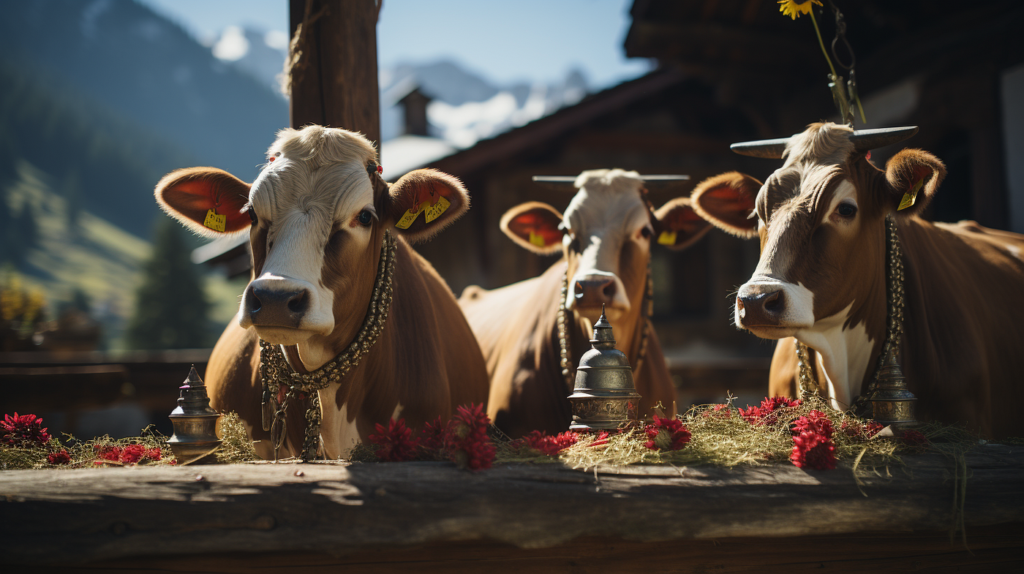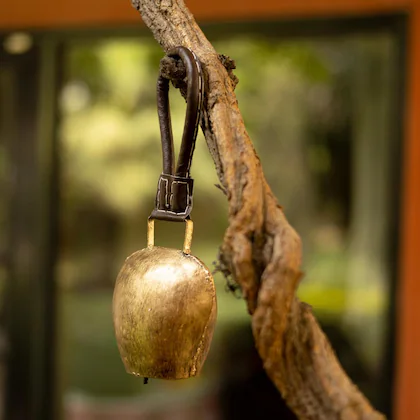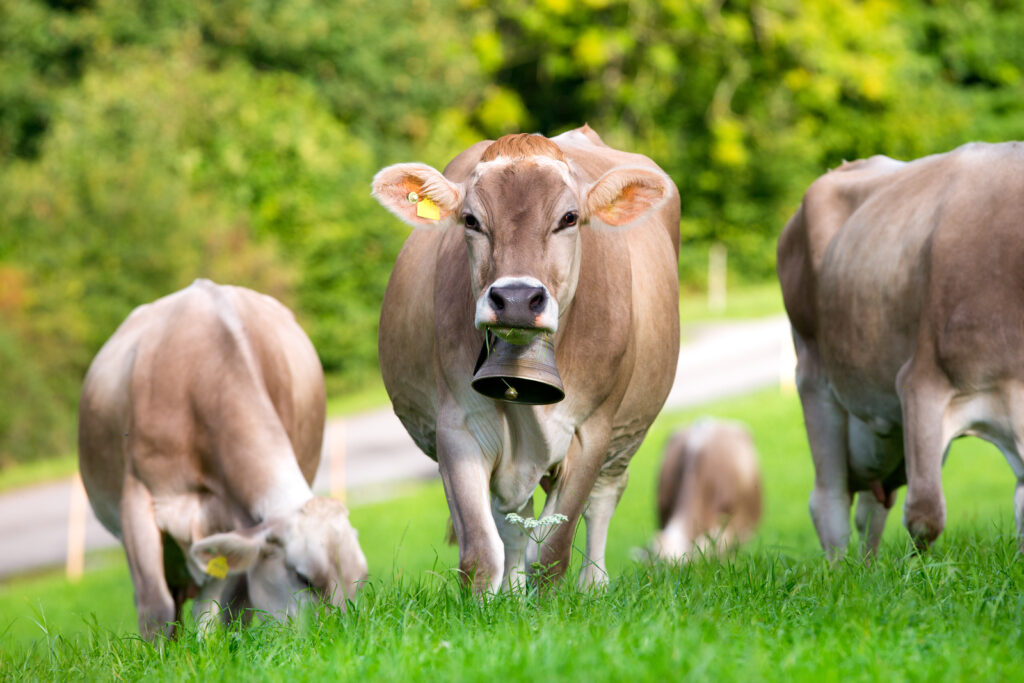A cow bell, also known as a ringer or bell, is a hollow bell typically made of cast metal or bronze that is worn around the neck of livestock, primarily cows and cattle. Its primary purpose is to help locate the animals when they are grazing in fields or roaming in pastures, especially in mountainous or forested areas where visibility may be limited.
The origins of cow bells can be traced back to ancient times when shepherds and herdsmen needed a way to keep track of their animals. The bell’s distinct ringing sound could be heard from a distance, allowing the herders to monitor the movement and location of their livestock without having to maintain constant visual contact.
Cow bells have been an integral part of pastoral life for centuries, serving both practical and cultural purposes. They have become iconic symbols of rural traditions and are deeply woven into the folklore and heritage of many regions around the world.
Table of Contents
The Traditional Uses of Cow Bells
Cow bells have been an integral part of traditional farming and herding practices for centuries. Their primary purpose was to help farmers and herders keep track of their livestock, particularly cattle, while they grazed in open fields or roamed in the mountains.
In rural areas, where livestock were allowed to graze freely, the jingling sound of cow bells helped farmers locate their animals easily. Each cow or group of cows would wear a distinct bell, allowing the herders to identify and monitor their movements from a distance. The bells also served as a deterrent against predators, as the constant ringing sound could scare away potential threats.
Cow bells played a crucial role in the daily routines of farmers and herders. In the morning, they would listen for the bells to ensure all their animals were accounted for, and in the evening, the bells guided them back to the herd for milking or shelter. The bells’ melodic chimes became a familiar and comforting sound in rural communities, signifying the rhythm of agricultural life.
Beyond their practical use, cow bells also held cultural significance in many farming communities. They were often decorated with intricate designs or engravings, reflecting the pride and craftsmanship of their makers. In some regions, the size, tone, and pattern of the bells were used to identify the ownership or lineage of the cattle, serving as a form of branding.
While modern farming practices have evolved, the traditional use of cow bells remains an enduring symbol of pastoral life and the deep connection between humans and their livestock.

The Sound of Cow Bells
Cow bells produce a distinctive, resonant tone that has become ingrained in the cultural fabric of many regions around the world. Their sound is unmistakable – a rich, melodic ringing that carries across fields and meadows.
The tone of a cow bell is determined by several factors, including its size, shape, and the material from which it is crafted. Traditionally, cow bells were made from cast bronze or wrought iron, lending them a warm, mellow timbre. The larger the bell, the deeper and more resonant its tone, while smaller bells produce higher-pitched, more tinkling sounds.
When a cow bell is struck or shaken, the clapper inside strikes the sides of the bell, causing it to vibrate and produce its characteristic ring. The bell’s shape and thickness also play a role in shaping the sound, with thicker bells producing a more sustained, reverberant tone.
One of the most distinctive qualities of cow bell sounds is their ability to carry over long distances. The resonant tones can travel for miles, making them ideal for locating herds in alpine regions or vast pastures. This quality has also made cow bells a popular choice for signaling in various cultural traditions and events.
Overall, the sound of cow bells is both melodic and evocative, conjuring images of pastoral landscapes, traditional practices, and a connection to the natural world.
Cow Bells in Culture and Folklore
Cow bells have held significant cultural and symbolic meanings across various traditions and folklore for centuries. In many pastoral societies, the melodic jingle of cow bells was not just a practical tool for locating livestock, but a deeply ingrained part of their cultural identity.
In the Swiss Alps, cow bells were traditionally adorned with intricate designs and motifs, each representing different villages or regions. These bells were not merely functional objects but works of art, reflecting the pride and craftsmanship of the local communities. The sound of cow bells echoing through the valleys was a cherished part of the Alpine experience, symbolizing the harmony between humans and nature.
In Hinduism, the cow is considered a sacred animal, and cow bells have been used in religious ceremonies and rituals. The ringing of the bell is believed to ward off evil spirits and bring good luck. In some regions, cow bells are hung in temples and homes, with their gentle chimes creating a sense of peace and tranquility.
In Native American cultures, cow bells were often incorporated into traditional dances and ceremonies. The rhythmic jingling of the bells was thought to connect the dancers with the spirits of nature and the rhythms of the earth. Cow bells were also used in healing rituals, with the sound believed to have purifying and cleansing properties.
In many rural communities around the world, the sound of cow bells has become a symbol of pastoral life, evoking images of lush meadows, grazing cattle, and a simpler way of living. The gentle ringing of the bells has been romanticized in literature, art, and music, capturing the essence of a bygone era and the enduring connection between humans and their livestock.
Cow Bells in Music
Cow bells have transcended their traditional use on farms and pastures, finding a place in various genres of music. Their distinctive and percussive sound has made them a popular addition to drum kits and percussion sections.
One of the most iconic uses of the cow bell in music is in the 1976 hit song “Don’t Fear the Reaper” by the American rock band Blue Öyster Cult. The memorable cowbell part, played by producer Rick Derringer, has become a cultural phenomenon and a subject of parody and celebration in popular media.
Beyond rock music, cow bells have been embraced by various other genres. In reggae and ska, the cow bell’s upbeat rhythms have become a staple, adding energy and groove to the music. Artists like Bob Marley and Jimmy Cliff have incorporated cow bells into their recordings, creating a distinctive sound that has become synonymous with the genres.
In Latin and Afro-Cuban music, the cow bell is often used as a percussive instrument, providing rhythmic accents and driving the beat. Salsa, merengue, and other Latin styles frequently feature cow bells, adding a vibrant and lively element to the music.
Even in hip-hop and electronic music, producers and artists have sampled and incorporated cow bell sounds into their tracks, creating unique and catchy rhythms. The cow bell’s distinctive tone has become a sought-after element in beat-making and music production.
While the cow bell’s primary function was once to locate livestock, its musical applications have given it a new life and a place in the pantheon of percussion instruments. From rock anthems to reggae grooves, the humble cow bell has proven its versatility and enduring appeal in the world of music.

Cow Bell Designs and Styles
Cow bells come in a wide array of designs and styles, reflecting the diverse cultures and regions where they originated. Each region has developed its own distinct aesthetic and crafting techniques, resulting in a rich tapestry of cow bell artistry.
In the Swiss Alps, cow bells are often made from brass or bronze, with intricate engravings and embellishments. These bells are typically larger and deeper in tone, designed to carry sound over long distances in the mountainous terrain. Swiss cow bells may feature intricate floral or animal motifs, as well as the name of the cow or the farm it belongs to.
In contrast, the cow bells of the Bavarian region of Germany tend to be smaller and more delicate, with a higher-pitched ring. These bells are often crafted from iron or steel and may be painted in vibrant colors or adorned with simple geometric patterns. Bavarian cow bells are prized for their clear, melodic tones.
In the Scandinavian countries, cow bells are frequently made from wood, such as pine or birch. These wooden bells have a warm, mellow sound and are often decorated with traditional Norse designs or runic symbols. Scandinavian cow bells may also feature intricate carvings or be painted in bright, cheerful colors.
The cow bells of the Himalayan regions of Nepal and Bhutan are typically made from brass or bronze, with a deep, resonant tone. These bells are often adorned with intricate designs and symbols from Buddhist or Hindu traditions, reflecting the rich cultural heritage of the region.
In the Americas, cow bells have been influenced by both indigenous and European traditions. In the Andes region of South America, cow bells are often crafted from copper or bronze, with designs inspired by pre-Columbian art and symbolism. These bells are prized for their rich, resonant tones.
No matter the region or design, cow bells are a testament to the ingenuity and artistry of their makers. Each bell is a unique creation, reflecting the cultural traditions and natural materials of its place of origin.
Cow Bell Makers and Artisans
The making of cow bells is an age-old craft that has been passed down through generations of skilled artisans. Traditionally, cow bells were crafted by blacksmiths and metalworkers who specialized in this unique form of metalwork. These artisans would carefully shape and forge the bell from various metals, often using techniques that were specific to their region or cultural traditions.
In many parts of the world, cow bell making was a family trade, with the knowledge and skills being handed down from parent to child. Each family or workshop would have their own unique styles and designs, resulting in a rich diversity of cow bell shapes, sizes, and decorative elements.
The process of making a traditional cow bell was labor-intensive and required a great deal of skill and patience. Artisans would start with a flat sheet of metal, which they would carefully shape and form into the bell’s body. The clapper, or striker, would be crafted separately and then attached to the inside of the bell. Decorative elements, such as intricate engravings or embossed designs, were often added to the exterior of the bell, giving each one a distinctive and unique appearance.
While the traditional methods of cow bell making are still practiced in some regions, modern manufacturing techniques have also been adopted by many makers. However, many artisans and small workshops continue to produce handcrafted cow bells, preserving the age-old techniques and ensuring that this rich cultural heritage is not lost.
Today, cow bell makers can be found around the world, each with their own unique styles and approaches. Some focus on recreating traditional designs, while others experiment with new materials and innovative shapes. Regardless of their approach, these skilled artisans continue to keep the art of cow bell making alive, creating beautiful and functional pieces that not only serve a practical purpose but also celebrate the rich cultural heritage of this craft.
Cow Bells in Modern Times
While cow bells may have their roots in traditional agricultural practices, they have found new life and purpose in modern times. In many rural areas, cow bells are still used by farmers and ranchers to keep track of their livestock, particularly when grazing in open pastures or mountainous regions. The distinctive ringing sound helps farmers locate their animals and ensures their safety.
However, cow bells have also gained popularity beyond their functional use in agriculture. They have become sought-after decorative items, adding a rustic and charming touch to homes and gardens. Many people appreciate the nostalgic and pastoral aesthetic of cow bells, which evoke a sense of simplicity and connection with nature.
Cow bells can be found adorning porches, patios, and garden spaces, where their gentle ringing creates a soothing and peaceful ambiance. They are often incorporated into outdoor decor, hung from trees or incorporated into wind chimes and other decorative pieces. Some homeowners even use cow bells as doorbells, adding a unique and whimsical touch to their entryways.
In addition to their decorative appeal, cow bells have also become collectible items for enthusiasts. Antique cow bells, particularly those with intricate designs or historical significance, can fetch high prices at auctions and flea markets. Collectors often appreciate the craftsmanship and cultural significance of these bells, preserving them as pieces of history.
Overall, while cow bells may have originated as functional tools in agriculture, they have transcended their practical purposes and found new roles in modern times. Whether used on farms, as decorative accents, or as collectible items, cow bells continue to capture the imagination and appreciation of people, serving as reminders of simpler times and our connection to rural traditions.
Caring for and Maintaining Cow Bells
Cow bells are durable instruments, but proper care is essential to preserve their unique sound and appearance for years to come. Here are some tips for cleaning, storing, and maintaining cow bells:
Cleaning
- Use a soft, dry cloth to wipe away any dirt or debris from the bell’s surface after each use.
- For more stubborn grime, mix a small amount of mild soap with warm water and gently scrub the bell with a soft-bristled brush.
- Avoid using harsh chemicals or abrasive cleaners, as these can damage the bell’s finish or etch the metal.
- Thoroughly dry the bell after cleaning to prevent rust or tarnishing.
Storing
- Store cow bells in a cool, dry place away from direct sunlight or moisture.
- Wrap the bell in a soft cloth or place it in a protective case to prevent scratches or dents.
- Avoid storing cow bells in damp or humid environments, as this can lead to corrosion over time.
Preserving
- If your cow bell has a wooden or leather component, periodically treat it with a suitable conditioner or oil to keep the material supple and prevent cracking or drying.
- For metal bells, consider applying a thin layer of Renaissance wax or another metal polish to protect the finish and prevent tarnishing.
- Avoid exposing cow bells to extreme temperatures or rapid temperature changes, as this can cause the metal to expand or contract, potentially damaging the bell.
By following these simple care and maintenance tips, you can ensure your cow bell remains in excellent condition, preserving its unique sound and charm for generations to come.
The Future of Cow Bells
As we look ahead, cow bells are poised to maintain their cultural significance while also embracing new innovations and uses. While their traditional role in livestock management may diminish with advancing technology, cow bells are likely to endure as symbols of rural heritage and craftsmanship.
One potential area of innovation lies in the design and materials used for cow bells. Artisans and manufacturers may explore new alloys, shapes, and decorative elements to create unique and visually striking cow bells. These could become sought-after collectibles or even functional works of art, blending tradition with modern aesthetics.
Additionally, cow bells may find new applications in various industries. For example, they could be adapted as novel sound effects in film and television productions, adding an authentic touch to rural or pastoral scenes. Similarly, they may be incorporated into interactive exhibits or installations in museums or cultural centers, allowing visitors to experience the distinctive sound and history of cow bells firsthand.
Beyond practical uses, cow bells are likely to maintain their symbolic value in cultural celebrations and events. From traditional alpine festivals to music festivals and even fashion trends, the iconic sound and imagery of cow bells will continue to evoke a sense of nostalgia and connection to rural traditions.
As society becomes increasingly urbanized and disconnected from its agricultural roots, cow bells may serve as a reminder of our heritage and the importance of preserving traditional crafts and practices. They could inspire educational initiatives, workshops, and exhibitions that celebrate the art of bell-making and the cultural significance of these humble yet enduring objects.
Ultimately, the future of cow bells lies in their ability to adapt and evolve while retaining their essence as a timeless symbol of rural life and the enduring bond between humans and livestock. As long as there are communities that cherish their cultural heritage, cow bells will continue to ring out, echoing the stories and traditions of generations past while inspiring new interpretations and innovations.



